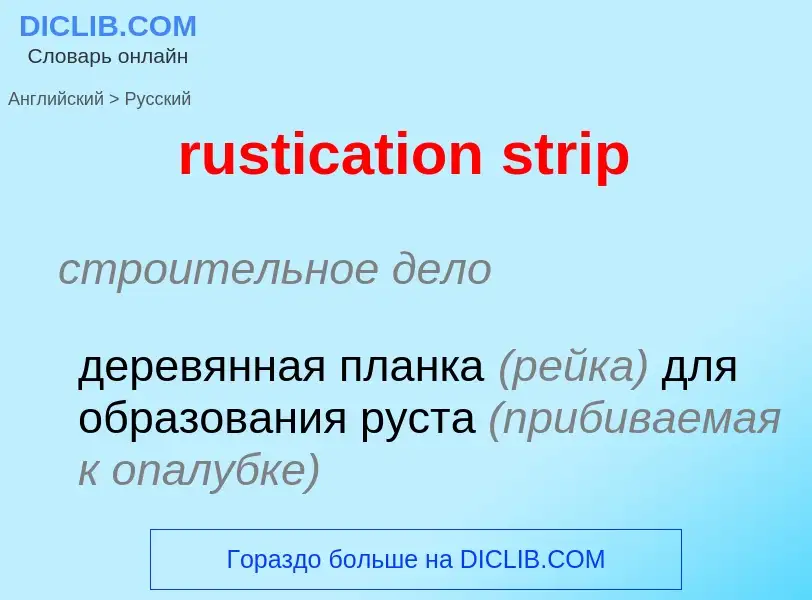ترجمة وتحليل الكلمات بواسطة الذكاء الاصطناعي
في هذه الصفحة يمكنك الحصول على تحليل مفصل لكلمة أو عبارة باستخدام أفضل تقنيات الذكاء الاصطناعي المتوفرة اليوم:
- كيف يتم استخدام الكلمة في اللغة
- تردد الكلمة
- ما إذا كانت الكلمة تستخدم في كثير من الأحيان في اللغة المنطوقة أو المكتوبة
- خيارات الترجمة إلى الروسية أو الإسبانية، على التوالي
- أمثلة على استخدام الكلمة (عدة عبارات مع الترجمة)
- أصل الكلمة
rustication strip - ترجمة إلى الروسية
строительное дело
деревянная планка (рейка) для образования руста (прибиваемая к опалубке)
[sai'kləupiən]
синоним
تعريف
ويكيبيديا
Rustication is a range of masonry techniques used in classical architecture giving visible surfaces a finish texture that contrasts with smooth, squared-block masonry called ashlar. The visible face of each individual block is cut back around the edges to make its size and placing very clear. In addition the central part of the face of each block may be given a deliberately rough or patterned surface.
Rusticated masonry is usually "dressed", or squared off neatly, on all sides of the stones except the face that will be visible when the stone is put in place. This is given wide joints that emphasize the edges of each block, by angling the edges ("channel-jointed"), or dropping them back a little. The main part of the exposed face may be worked flat and smooth or left with, or worked, to give a more or less rough or patterned surface. Rustication is often used to give visual weight to the ground floor in contrast to smooth ashlar above. Though intended to convey a "rustic" simplicity, the finish is highly artificial, and the faces of the stones often carefully worked to achieve an appearance of a coarse finish.
Rustication was used in ancient times, but became especially popular in the revived classical styles of Italian Renaissance architecture and that of subsequent periods, particularly in the lower floors of secular buildings. It remains in use in some modern architecture.
Similar finishes are very common in medieval architecture, especially in castles, walls and similar buildings, but here it merely arises from an unwillingness to spend the extra money required for ashlar masonry in a particular building, and lacks the deliberate emphasis on the joints between blocks. Though it often achieves a decorative effect, this is something of a by-product, and the exploitation for architectural effect within a single building of contrasts between rusticated and ashlar surfaces is rarely seen. In some buildings, such as the Palazzo Vecchio in Florence (begun 1298) something other than cost-saving is at play, and this may be the association of the technique with the display of power and strength, from its use in military architecture. Rough finishes on stone are also very common in architecture outside the European tradition, but these too would generally not be called rustication. For example, the bases of Japanese castles and other fortifications usually use rough stone, often very attractively.

![Serlio]], rusticated doorway of the type now called a [[Gibbs surround]], 1537 Serlio]], rusticated doorway of the type now called a [[Gibbs surround]], 1537](https://commons.wikimedia.org/wiki/Special:FilePath/Serlio XXIX.jpg?width=200)
![Vermiculation at 286 [[Boulevard Saint-Germain]], Paris Vermiculation at 286 [[Boulevard Saint-Germain]], Paris](https://commons.wikimedia.org/wiki/Special:FilePath/Boulevard Saint-Germain, 286 (vermiculure).jpg?width=200)
![An unusual pattern book of effects in the Loggia di [[Giulio Romano]] in [[Mantua]] An unusual pattern book of effects in the Loggia di [[Giulio Romano]] in [[Mantua]]](https://commons.wikimedia.org/wiki/Special:FilePath/3428MantovaPescherie.jpg?width=200)
![Diana Fountain]], London, c. 1690 Diana Fountain]], London, c. 1690](https://commons.wikimedia.org/wiki/Special:FilePath/Diana Fountain in Bushy Park 3 (cropped).jpg?width=200)
![Smooth-faced rustication with the blocks dropping back to the wall at 90°, rather than a "V" [[chamfer]] Smooth-faced rustication with the blocks dropping back to the wall at 90°, rather than a "V" [[chamfer]]](https://commons.wikimedia.org/wiki/Special:FilePath/Scotland Yard plaque.jpg?width=200)
![Banded rustication in a wholly modern context, [[Hattiesburg, Mississippi]] Banded rustication in a wholly modern context, [[Hattiesburg, Mississippi]]](https://commons.wikimedia.org/wiki/Special:FilePath/Liberal Arts Building (3298746194).jpg?width=200)
![Late 15th-century gateway to the [[Palacio de Jabalquinto]], with small "diamonds" erupting from [[ashlar]] at the sides Late 15th-century gateway to the [[Palacio de Jabalquinto]], with small "diamonds" erupting from [[ashlar]] at the sides](https://commons.wikimedia.org/wiki/Special:FilePath/Fachada Palacio Jabalquinto Baeza.jpg?width=200)
![[[Palazzo dei Diamanti]], [[Ferrara]] [[Palazzo dei Diamanti]], [[Ferrara]]](https://commons.wikimedia.org/wiki/Special:FilePath/Palazzo dei Diamanti, Ferrara 07.jpg?width=200)
![[[Casa dos Bicos]], [[Lisbon]] [[Casa dos Bicos]], [[Lisbon]]](https://commons.wikimedia.org/wiki/Special:FilePath/Casa dos Bicos - Lisboa.jpg?width=200)

